- Energy consumption in Malaysia
- Oil
- Natural Gas
- Electricity
- Power Consumption and Capacity
- Renewable Energy Sources
- What does Malaysia need from its energy?
- Possible Solutions
Energy Consumption in Malaysia
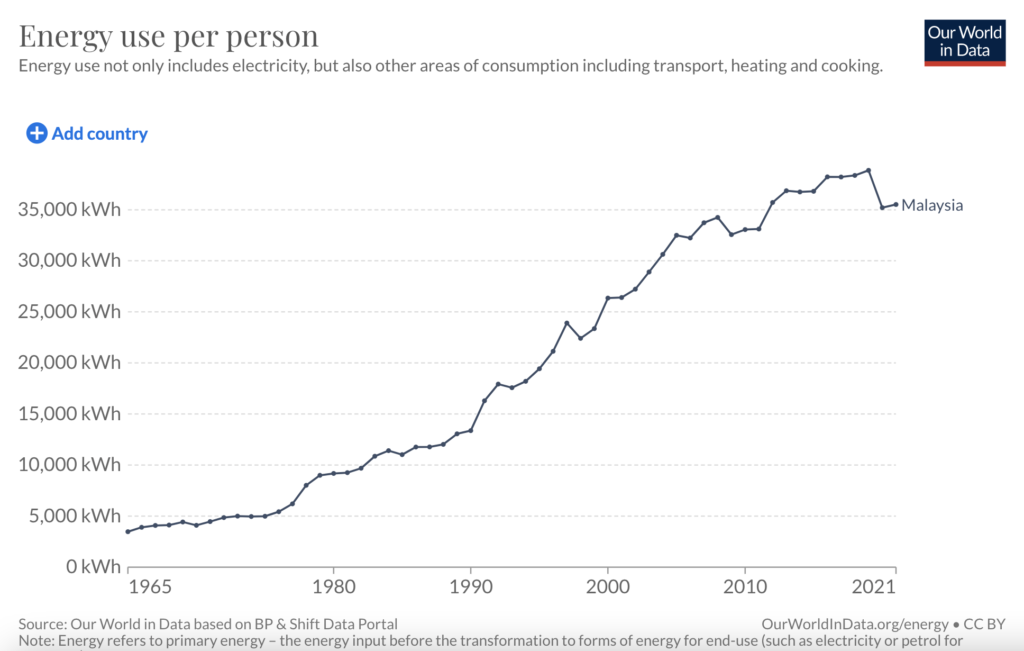
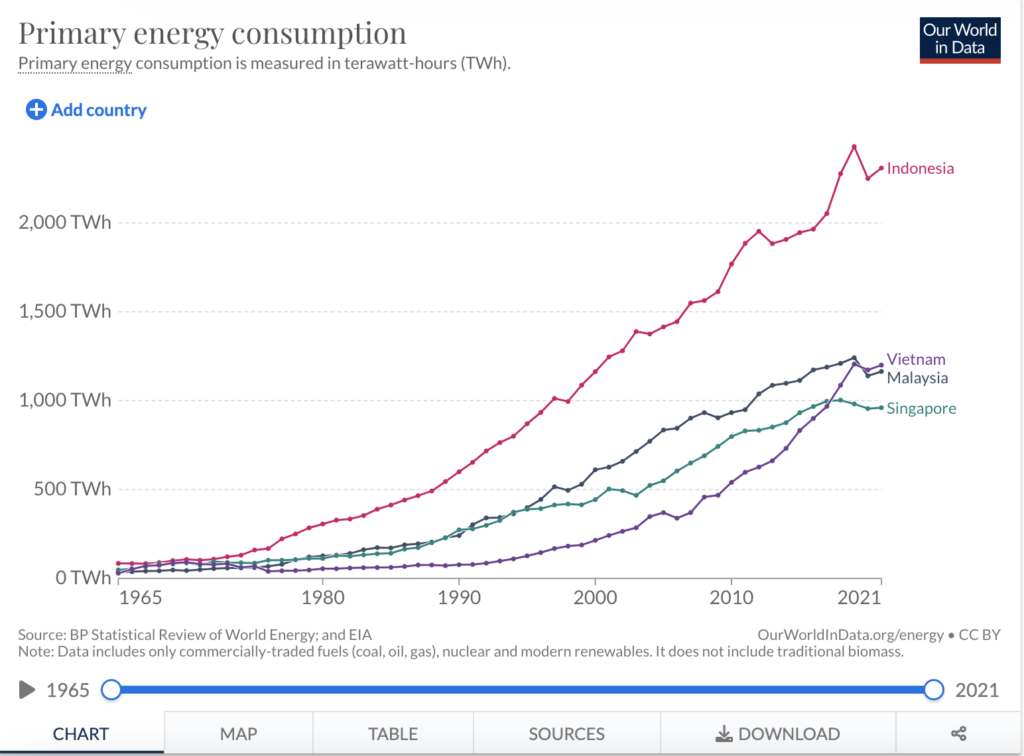
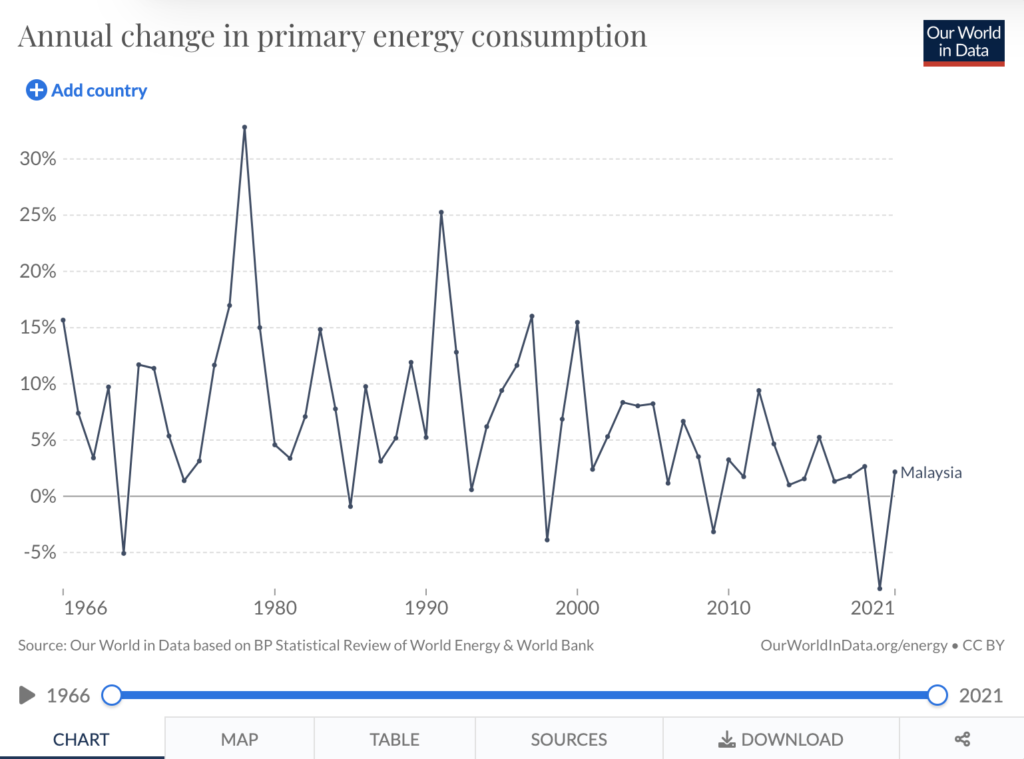
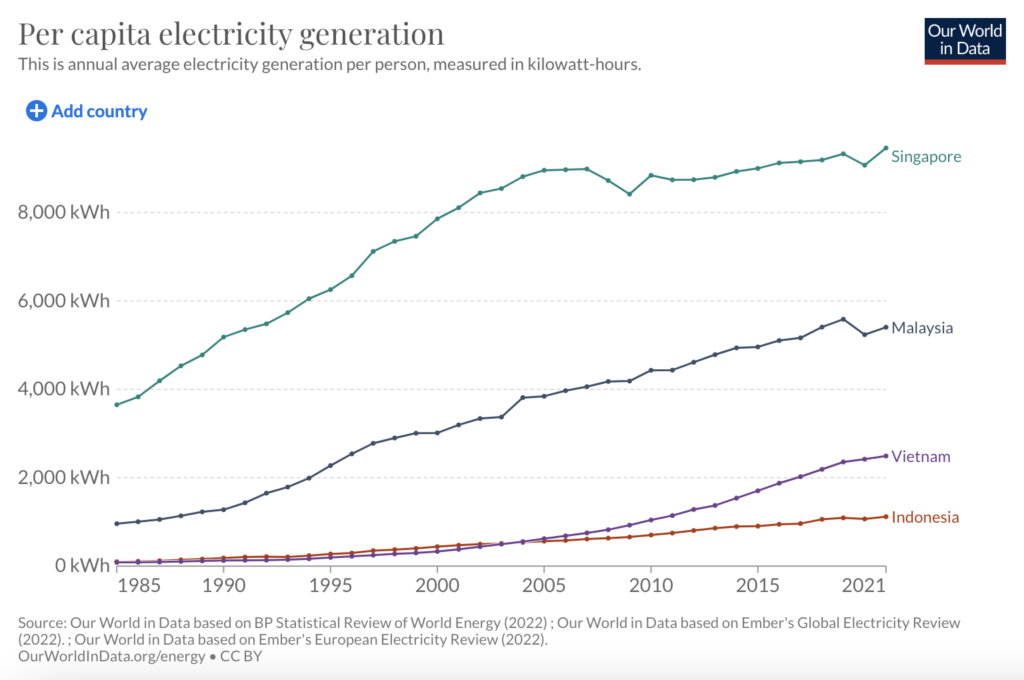

The report by the United States Energy Information Administration, from which the graph above is taken from, explains the following about Malaysia’s oil. Any sections in speech or quotation marks are from the same report.
Oil
- “Malaysia is the second–largest oil and natural gas producer in Southeast Asia and is the fifth–largest exporter of liquefied natural gas (LNG) in the world, as of 2019. It is strategically located on important routes for seaborne energy trade.“
- “Malaysia’s energy industry is an important sector of growth for the economy. The government has focused on increasing hydrocarbon production through upstream investment and exploration as a driver of economic growth, but pursuing this strategy has become increasingly challenging because production has been declining as a result of maturing fields and a lack of developed new fields.”
- “According to the Oil & Gas Journal (OGJ), Malaysia held proved oil reserves of 3.6 billion barrels as of January 2020, the fourth-largest reserves in Asia Pacific after China, India, and Vietnam.6 Nearly all of Malaysia’s oil comes from offshore fields.”
- “Total liquid fuels production in 2019 was an estimated 712,000 barrels per day (b/d), of which about 600,000 b/d was crude oil. Total liquid fuels production has declined after reaching a high point of 762,000 b/d for the decade in 2016 (Figure 1).”
- “Malaysia wants to expand its oil storage capacity because its need for more oil storage is growing because of increasing crude oil trade in the region. Singapore also faces capacity constraints to oil storage, which Malaysia seeks to capitalize on by becoming an alternative provider for oil storage in the region.”

Natural Gas.
- “Malaysia is one of the world’s largest natural gas producers and exporters. Petronas is the dominant player in the natural gas sector.”
- “Shell is one of the largest natural gas producers operating in Malaysia after Petronas and is a key player in the development of deepwater fields in Malaysia. Other international companies that have sizeable upstream investments in Malaysia’s natural gas fields include ExxonMobil, JX Nippon Oil & Gas, PTT Exploration and Production Public Company Limited (PTTEP), and Pertamina.”
- “According to the OGJ, Malaysia holds 41.8 trillion cubic feet (Tcf) of proved natural gas reserves as of January 2020.”
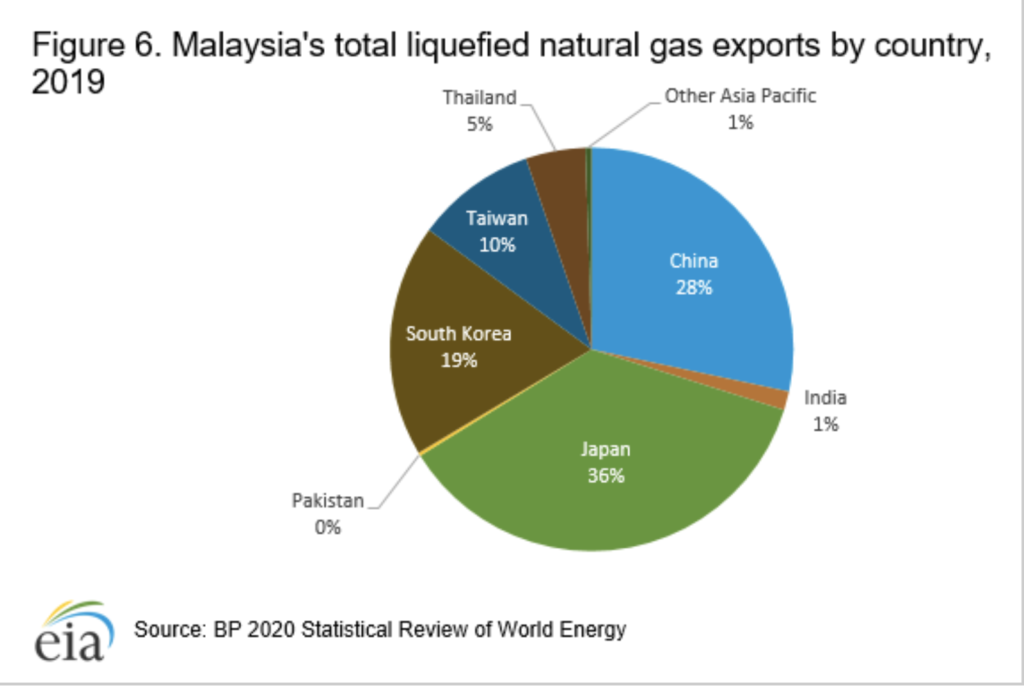
Electricity
- The Malaysian government approved a new 10-year plan to reform the country’s power sector. The Malaysian Electricity Supply Industry 2.0 (MESI 2.0) aims to liberalize the power industry and promote the use of renewable energy for power generation.
- Malaysia’s three main power transmission grids are located in Peninsular Malaysia, Sarawak, and Sabah. The National Grid in Peninsular Malaysia, the largest of the three, is interconnected with Thailand’s and Singapore’s electricity grids.
Power Generation and Capacity
- “Malaysia’s electricity demand, met mostly by natural gas and coal, continues to expand rapidly.“
- “Total installed generation capacity at the end of 2018 was about 34 gigawatts (GW), located mostly in Peninsular Malaysia.36 Fossil fuels, primarily coal and natural gas, accounted for about 78% of Malaysia’s installed capacity at the end of 2018 and 83% of the country’s electricity output in 2018.”
- “The high-demand centers, particularly in Peninsular Malaysia, are facing shortages of natural gas and a need for greater generation capacity.”
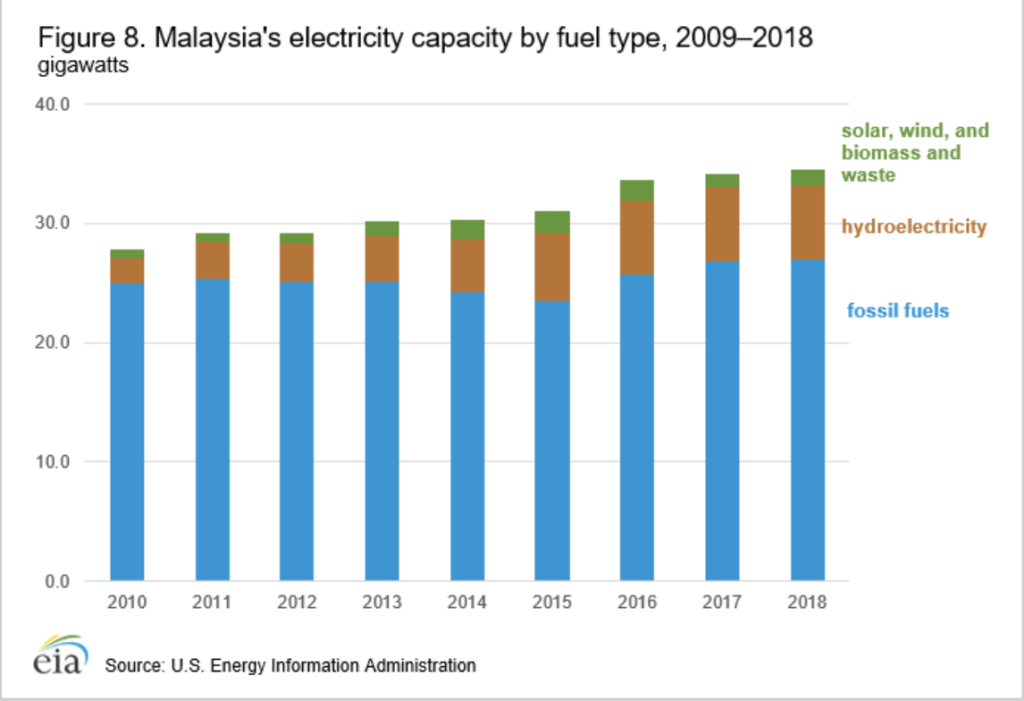
Coal
- “Coal, which accounted for 43% of power generation in 2018, has become much more economically competitive with natural gas for power generation.”
- “Nearly all of its domestic coal reserves are located in Sarawak, and Malaysia relies heavily on imports for coal.41 Most of Malaysia’s coal imports come from Indonesia and Australia, and Malaysia imported approximately 38 million short tons in 2019.”
Renewable Energy Sources
- “The government has begun prioritizing clean energy and aims to achieve a capacity mix of 25% in renewables by 2025 in order to reduce its greenhouse emissions and to diversify its power fuel mix.”
- “Malaysia is significantly expanding its use of hydroelectricity, which accounted for 18% of Malaysia’s total installed capacity and 17% of electricity generation in 2017.”
What does Malaysia need from its energy?
A. Revenue
Revenue
Three of the twenty largest companies in Malaysia are owned by Petronas. They also contribute a huge amount of revenue for the government (35% of total revenue) .

…so if Malaysia relies on Petronas so much for its revenue, the government probably should work with the company going forward.
Paris Agreement
Malaysia also needs to reduce its contribution to Global Greenhouse Gases because it was a signatory to the Paris Agreement of 2016.

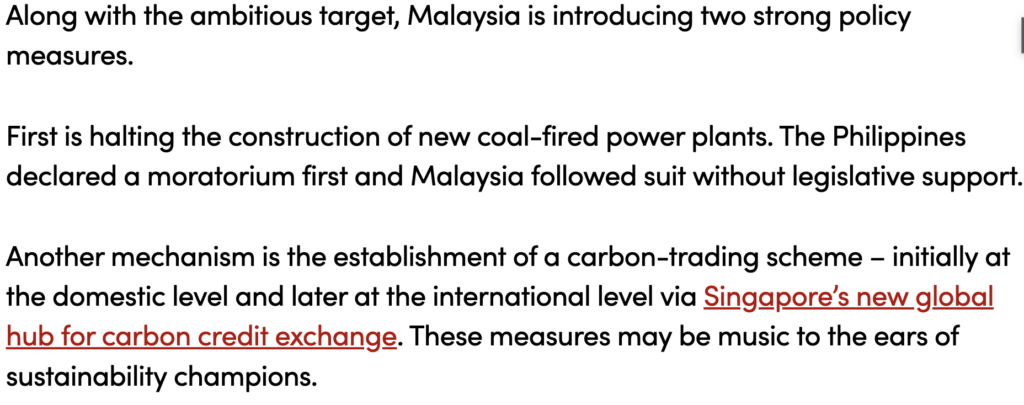
and …
“The Malaysian palm oil industry is anticipated to play a major role in the reductions. The use of palm-based biofuels and bioenergy is expected to reduce GHG emissions by up to 82%, compared to conventional fossil fuels.4 By 2020, when palm oil mills in Malaysia are all fully-equipped with biogas capture facilities, the carbon footprint for Malaysian palm oil is estimated towards reduction by 53%.5“
Possible Solutions
Malaysia is a developing nation or MIC so arguably is still in need of cheaper energy sources to become a developed country. But it also wants to help the environment too. The story below is just one example of this.
Malaysia’s Petronas launches clean energy firm to lead carbon-free push
From the graph below, Malaysia has reduced its reliance on oil and natural gas and increased its energy consumption with coal and hydropower. Like other countries, it seems it is trying to strike a balance between its available natural resources (allowing for cheaper energy for its people and a huge revenue-making industry) and an attempt to use more renewables.

…and it is reducing its reliance on fossil fuels too.

Key questions like the following need answering for the future of Malaysian energy.
- As a developing country, what are the most efficient and cheap energy sources?
- Can Malaysia afford not to invest heavily in renewable energies? What would happen to their global reputation if they did not?
- With regards to energy and both renewables and non-renewables , what are the geographical advantages Malaysia has?
- How many people are employed in the Malaysian energy industries?
There are lots of useful graphs and analysis in the following sources:
